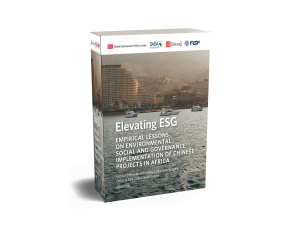China is an important partner in providing critically needed finance and infrastructure development capacity for African countries. With a growing awareness of environmental, social and governance (ESG) risks associated with infrastructure development, it is important to consider to what degree development projects cause ESG-related harm to host countries and communities.
Are Chinese-financed development projects in Africa meeting China’s stated ESG guidelines?
A new report uses a consistent ESG framework based on stated Chinese and local ESG requirements and recommendations to analyze five Chinese projects in three African countries that are recipients of large amounts of Chinese financing on the African continent – Egypt, Nigeria and Ethiopia – and two sectors: energy and industrial parks, which are aligned with China’s ambitions to enhance energy access and support manufacturing in Africa. The report also assessed the case studies’ potential risks to biodiversity and Indigenous lands, based on their spatial locations.
The report finds that the case study projects do not meet the standards of China’s recommended ESG guidance, signaling significant room for improvement.
The report is a collaboration between the Boston University Global Development Policy Center, the Fudan University Green Finance and Development Center, the South African Institute of International Affairs and LSE IDEAS.
Main findings:
- In Egypt, the Tianjin Economic-Technological Development Area (TEDA)-Suez Special Economic Zone and Sinohydro’s Attaqa Hydroelectric Power Plant showed Chinese firms adhering to the host country’s minimum ESG standards, while also taking advantage of regulatory gaps around labor conditions and taxation.
- The TEDA-Suez project was found to have the highest risk to biodiversity compared to other projects and average risks for World Bank and Chinese development-financed projects. The TEDA project presented some potential risk to Indigenous lands, albeit lower than the average for Chinese development-financed projects.
- In Nigeria, the Lekki Free Zone (LFZ) project exhibited notable ESG risks related to community relocation and compensation, but also potential benefits including job creation and infrastructure development. The LFZ showed negligible risk to Indigenous lands due to its distance from these areas.
- In Ethiopia, institutional weaknesses and inadequate regulatory frameworks posed challenges to ESG implementation in the examined projects: the Eastern Industrial Zone (EIZ) and the Grand Ethiopian Renaissance Dam (GERD) and Renaissance-Addis transmission line. Specific issues included delays in land compensation, poor coordination among public servants and deficiencies in human resources and government funding.
- The EIZ and the Renaissance-Addis Power Transmission Line were found to be partially or entirely located on Indigenous lands, leading to higher risk scores.
The report concludes by identifying recommendations for key Chinese, African and international stakeholders to improve ESG practices for Chinese-financed projects in Africa.
The case studies underscore the critical importance of robust, well-enforced ESG standards and regulatory frameworks, as well as the need for transparency, stakeholder engagement and institutional capacity building to ensure sustainable and socially responsible project outcomes.





Comments are closed.